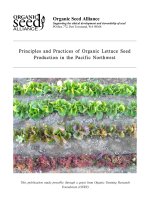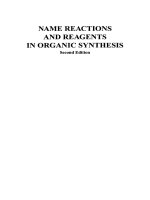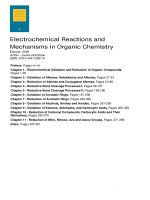name reactions and reagents in organic synthesis
Bạn đang xem bản rút gọn của tài liệu. Xem và tải ngay bản đầy đủ của tài liệu tại đây (3.21 MB, 90 trang )
NAME REACTIONS
AND REAGENTS
IN ORGANIC SYNTHESIS
Second
Edition
Bradford
P.
Mundy
Prof.
of
Chemistry, Emeritus
Colby College
Waterville,
ME
Michael
G.
Ellerd
Maxim Technologies
Bozeman, MT
Frank
G.
Favaloro, Jr.
Helicon Therapeutics
Farmingdale,
NY
WILEY-
INTERSCIENCE
A
JOHN
WILEY
&
SONS, INC., PUBLICATION
This Page Intentionally Left BlankThis Page Intentionally Left BlankThis Page Intentionally Left BlankThis Page Intentionally Left BlankThis Page Intentionally Left BlankThis Page Intentionally Left BlankThis Page Intentionally Left BlankThis Page Intentionally Left BlankThis Page Intentionally Left BlankThis Page Intentionally Left Blank
This page Intentionally Left Blank
NAME REACTIONS
AND REAGENTS
IN ORGANIC SYNTHESIS
This Page Intentionally Left BlankThis Page Intentionally Left BlankThis Page Intentionally Left BlankThis Page Intentionally Left BlankThis Page Intentionally Left BlankThis Page Intentionally Left BlankThis Page Intentionally Left BlankThis Page Intentionally Left BlankThis Page Intentionally Left BlankThis Page Intentionally Left Blank
This page Intentionally Left Blank
NAME REACTIONS
AND REAGENTS
IN ORGANIC SYNTHESIS
Second
Edition
Bradford
P.
Mundy
Prof.
of
Chemistry, Emeritus
Colby College
Waterville,
ME
Michael
G.
Ellerd
Maxim Technologies
Bozeman, MT
Frank
G.
Favaloro, Jr.
Helicon Therapeutics
Farmingdale,
NY
WILEY-
INTERSCIENCE
A
JOHN
WILEY
&
SONS, INC., PUBLICATION
Copyright
0
2005 by
John
Wiley
&
Sons,
Inc. All rights reserved.
Published by John Wiley
&
Sons,
Inc., Hoboken, New Jsersey.
Published simultaneously in Canada.
No part of this publication may be reproduced, stored in a retrieval system,
or
transmitted in any
form
or
by any means, electronic, mechanical, photocop:ying, scanning, or otherwise, except as
permitted under Section 107
or
108 of the 1976 United States Copyright Act, without either the prior
written permission of the publisher,
or
authorization throsugh payment of the appropriate per-copy
fee to the Copyright Clearance Center, Inc., 222 Rosewood Drive, Danvers, MA 01923,978-750-
8400, fax 978-646-8600,
or
on
the web at www.coPyright.com. Requests to the publisher for
permission should be addressed to the Permissions Department,
John
Wiley
&
Sons,
Inc., 11
1
River
Street, Hoboken,
NJ
07030. (201) 748-6008, fax (201) 748-6008.
Limit of LiabilitylDisclaimer of Warranty: While the publisher and author have used their best
efforts in preparing this book, they make no representations
or
warranties with respect to the
accuracy
or
completeness of the contents of this book and specifically disclaim any implied
warranties of merchantability
or
fitness for a particular piurpose. No warranty may be created
or
extended by sales representatives
or
written sales materia.ls. The advice and strategies contained
herin may not be suitable for your situation.
You
should consult with a professional where
appropriate. Neither the publisher
nor
author shall be lialble for any
loss
of profit
or
any commercial
damages, including but not limited to special, incidental, consequential,
or
other damages.
For
general information
on
our
products and services contact
our
Customer Care Department within
the
U.S.
at 877-762-2974, outside the US. at 317-572-3993
or
fax 317-572-4002.
Wiley also publishes its books in a variety of electronic formats. Some content that appears in print,
however, may not be available in electronic format.
Library
of
Congress Cataloging-in-Publication Data is available.
ISBN 0-471-22854-0
Printed in the United States of America
10987654321
Preface
It has been a long haul. The start for this revision came almost the same way that the original
edition started. For the fnst edition it was Mike Ellerd, then an undergraduate at Montana State, who
organized my crude Name Reaction handouts
so
well that others encouraged the conversion into a
book. At Colby College, Frank Favaloro did the same thing, making “study sheets” and adding to
the list of Name Reactions. He graduated
in
1996
and
I
started reformatting and expanding. With
encouragement from Darla Henderson, this became a project. By then Frank had finished graduate
school and was enthusiastic about participating.
I
had also retired from formal teaching and found
much more time for creative work. The three of
us
started to work in earnest!
This edition differs substantially from the fmt by the inclusion of many modem Name
Reactions instead of sticking exclusively with the
old, tried and true. There are many reactions not
covered; indeed, we ultimately eliminated those that had little contemporary use. We generally
applied a “rule of thumb” that a newer name had to
be
cited by multiple authors. Therefore there are
some relatively new protocols that have not stood the test of time; however the breadth of recent use
warranted inclusion.
As
for reagents, we have focused on both Name Reagents and those whose
acronyms are often used in place of the actual name.
We
have noted the common use of these forms
in current literature.
First and foremost, this is a
book
to be used. Feel free to write in the text. .
.
use any available
blank space to add your own notes. Transform this intoyow book of Name Reactions! It is
intended to serve as a starting point. Within a
two page format for reactions and one page for
reagents, the reader will fmd a basic, generalized defmition
/
formula, a mechanism that conveys a
possible course from starting material to product, notes which describe a few of the major highlights
of the reaction
or
which points the reader to related reactions (by name
or
similarity) and recent
examples of use. We have tried to convey the current mechanistic thinking with special care to show
intermediate steps, point out proton exchanges, and sometimes suggest transition states, but without
going
through
kinetics, isotope effects, etc.
Wherever appropriate, we have included references to selected secondary sources. They
contain more detailed discussions
on the topics introduced in this book. In all cases, we recommend
use of the primary literature. The examples in the following pages
are
but a small taste of the detail,
variation, scope and experimental detail available. Our choices reflect our personal interests; there is
no “better
or
worse” implied! We tried
to
use current examples from journals that seem to be most
commonly accessible, both in paper form and electronically, to student and professional alike.
When recent references were difficult to come by, we made use of the abstracts and reaction-search
engine of
SciFinder
(American Chemical Society).
In
these cases, we supplied a number [AN year:
XXXX]
that will allow ready access to the abstract. To the authors of the works we have chosen to
describe, we hold the most sincere gratitude and we hope we have faithfully represented your work.
Colby College
Waterville, ME
Feb
1,2005
ACKNOWLEDGMENTS
As always, completion of a project requires more than just the work of the authors. Without the
consideration, support and patience of spouses: Margaret (Brad), Mary (Mike) and Michelle (Frank),
this probably could not have been completed.
methods for creating C-C and C-heteroatom bonds. It has been an enlightening experience to
chronicle the explosion of new “named” reactions and protocols. We have not lost view of the
obvious new participation
of
the world chemical community.
Each of
us
can thank mentors and spe’cial people that have given
us
encouragement:
Special thanks goes
to
the chemistry community for their endless development of new
Brad:
I
still owe much to my formal mentors:
Richard F. Smith who first provided the excitement
of
chemistry, A.Paul Krapcho, graduate mentor
and friend, and the late Henry Rapoport, postdoctoral advisor.
help in reading parts of this manuscript. And, of c:ourse my former graduate and undergraduate
students
. . .
two of the latter are now coauthors, who were the reason for my continued interest in
the academic life. Special thanks goes to Prof.Tom Poon (Claremont McKenna, Pitzer,
&
Scripps
Colleges) for a great two years as a Dreyfus Fellow with me at Colby. He taught me much, and
worked closely with Frank Favaloro.
the Science Library could always be depended on to solve any library problem that developed in the
absolutely great electronic resources of Colby College, and patiently put up with my many requests,
piled up books and journals and general
use
of the library. The Colby College
ITS
staff was
extremely good-natured and helpfd for computer questions. Their help was greatly appreciated.
Mike:
My appreciation goes out to all of my professors at Montana State, who,years ago sparked my
interest in chemistry, and to those who still today keep that interest very much alive.
Frank:
I
would like to thank all of those who not only taught me organic chemistry, but also to be excited
for the art it contains: Gordon W. Gribble, Tadashi Honda, Thomas Spencer, Peter Jacobi, David
Lemal, Thomas Poon, Philip Previte and, most i,mportantly, Brad Mundy. Thank you to the many
friends and co-workers who provided support, advice and the occasional reference: Erin Pelkey,
Janeta Popovici-Muller, Tara Kishbaugh, Jeanese Badenock, Alison Rinderspacher and Chaoyang
Dai.
I
thank my colleagues from Colby College, Dasan Thamattoor and Jeff Katz, for their
I
would like to thank several Colby staff that made my working easier: Susan W. Cole of
Of course a project with a publisher requires interaction. Darla Henderson, Amy Byers,
Camille Carter and Dean Gonzalez were the peoplle who kept the ball rolling and the project in
focus.
Colby College
Waterville,
ME
Feb
1,2005
vi
CONTENTS
Acronyms and Abbreviations
/
viii
NameReactions
/
1
Name Reagents and Acronyms
/
714
Index
/872
vii
ACRONYMS AND
ABBREVIATIONS
Acronvm
Ac
Acac
AcOH
(HOAc)
AIBN
ACN
BZNAP
BZNOL
BITIP
Name
Acetyl
Acetylacetonate
Acetic acid
2,2’-Azobisisobutyronitrile
1,l ’-Azobis- 1-cyclohexanenitrile
9-Borobicyclo[3.3. llnonane
2,2’-Bis(Diphenylphosphino)-l,
1
’-
binaphththyl
1,l ’-bi-2,2’-naphthol
BinolKitanium isopropoxide
Bromomagnesium Diisopropylamide
Borane Dimethylsulfide
Me
Me
Me
-COOH
NC+-
N=
N-
LCN
\
Me
Me
H
A
Ti(iPr0)4
/
BINOL
BH3-Me2S
viii
-
EMS
Bn-
Borane Dimethylsulfide
Benzyl
Bs
Bu&H
Bz
-
CAN
-
CAS
I
Brosylate
tri-"butylstannane
Benzoyl
Ceric ammonium nitrate
Ceric ammonium sulfate
BOC-
(t-Boc)
-
-
cod
t-Butoxycarbonylchloride
Cyclooctadiene
BB
Benzyloxymethyl-
CP
Cyclopentadienyl
-
Cbz-
Carbobenzyloxy
-
CDI
1,l
'-Carbonyldiimidazole
I
Cetyl
I
Hexadeca-
CP*
Tetramethylcyclopentadienyl
-
CSA
Camphorsulfonic Acid
DABCO
TED
-
1,4-Diazabicylo[2.2.2]octane,
TED,
triethylenediamine
Me
Me&
Me
Me
HO,S-H,
3
DEIPS
DET
DZBAL
DZBAL-H
DIPEA
Diplvme
Diethylamino)sulfur trifluoride
Dicyclohexylcarbodiimide
2,3-Dichloro-5,6-dicyano-
1,4-
benzoquinone
Dimethyldioxirane
Diethyl Azodicarboxylate
Diethylisopropylsilyl
Dietkyl tartrate
Disobutylaluminum hydride
Diisopropylethylamine
Hunip's
base
Diisopropyl tartrate
Diethylene glycol dimethyl ether
Acronyms and Abbreviations
Et,
Et)
N
-SF,
NC
Nc+
0
CI
Me
Me
EtOOC-N=N-COOEt
Et
i-Pr -hi
-$
E(
YH
EtOOC -CHCH-COOEt
I
HO
in
R-,
S,
and meso
forms
Me
Me
$1
Me
h
dMe
Me
Me ( Me
Me-(NJ
Me
OH
iPrOOC -CHCH -COOiPr
I
I
HO
in
R-,
S,
and
meso
forms
MeO-O-OMe
cronyms and Abbrevii
DMAP
DMIPS
DMF
DMP
DMPU
DMS
DMSO
DNP
ee
Fmoc
ns
4-(Dimethylamino)pyridine
1,2-Dirnethoxyethane
Glyme
Dimethylisopropylsilyl
Dimethylformamide
Dimethylpyrazole
N,N'-Dimethylpropyleneurea
Dimethylsulfide
Dimethylsulfoxide
1,2-Bis(diphenyIphosphino)ethane
(DIPHOS)
enantiomeric excess
=
%
major enantiomer
-
%
minor
enantiomer
9-Fluoren ylmethoxycarbonyl
xi
Me
re
'N
Me0
5
OMe
Me
Me
Me
-S-Me
1:
A
Ph-P p-ph
Ph pi
I
n
Ph-P P-Ph
II
Ph Ph
Acronyms and Abbreviations
xii
I
IcLI~BH
r
LTMp
LiTMP
I
MCPBA
F
Ms
2-(6-Chloro- 1H-benzotriazole-
1
-yl)-
1,1,3,3-tetramethyIuronium
hexafluorophosphate
Hexamethylphosphoric triamide
Hexamethylenetetramine
Hydroxy(tosy1oxy)-iodobcnzene
Imidazoyl
Diisopinocampheylborane
Lead tetraacetate
Lithium 2,2,6,6-
tetramethylpiperidide
Methylaluminum bis(2,6-di-t-butyl-
4-methylphenoxide)
m-Chlorperoxybenzoic acid
Acetonitrile
2-Methoxyethoxymethyl
Mesyl
,
Methanesulfonyl
0
0
Me. Me
N’
-3
LN
h
?Ac
OAc
AcO -Pb -0Ac
I
Me-CzN
xonyms and Abbreviat
WTM
~~
WVK
NMP
PCC
PDC
Pd(dbaJ2
PMB
PNB
pTT
{PTAB)
ns
Methylthiomethyl
Methyl Vinyl Ketone
N-Bromosuccinimide
N-Chlorosuccinimide
4-Methylmorpholine
N-Methylmorpoline-N-oxide
N-Methylpynolidone
Pyridinium chlorochromate
Corey's Reagent
Pyridinium dichromate
Bis(dibenzy1ideneacetone)palladium
p-Methoxybenzyl
(0)
para-Nitrobenzoyl
Polyphosphoric Acid
Phenvltrimethvlammonium
tribrdmide
.
Phenyltrimethylammonium
perbromide
Xlll
OQO
I
Rr
OQO
&I
Me
I
Me
0
O+CI
0
H
0
or:
CrzOF2
2
h!eNO2
Unspecified mixture with
High
concentration
of
0";'"
0
Ph-N-Me
Br3
\
Me
"
Pv
SEM
SMEAH
TBDPS
TBS
TBDMS
TEA
TEBA
TEBAC
TEMPO
Pyridinium para-toluenesulfonate
p-Toluenesulfonic acid;
rosic acid
Pivaloyl
Pyridine
(R)-1-Amino-2-
Methoxymethylpyrrolidine
(S)-
1
-Amino-2-
Methoxymethylpyrrolidine
Ender's Reagent
2-Trimethylsilylethoxy-methoxy
Sodium Bis(2-
methoxyethoxy)aluminum Hydride
Tetrabutylammonium fluoride
tert-Butyldipheny lsily
l
t-Butyl hydroperoxide
tert-Butyldimethylsilyl
Triethylamine
Benzyltriethylammonium chloride
2,2,6,6-Tetramethylpiperidin-
1
-oxyl
Acronyms and Abbreviations
Me
Me
Me,
I
Si
Me'
-042
Ph
t-Bu \Si
-5
Ph'
0
cronyms and Abbreviat
TES
Tf
THF
THP
TIPS
TMEDA
TpAP
TPP
TMS
TMSOTf
TPS
Trt
Ts-
TOS-
ns
Triethylsilyl
Triflate
Tetrahydrofuran
Tetrah ydropyranyl
Triisopropylsilyl
N,N,N’,N’-
Tetramethylethylenediamine
Tetra-n-Propylammonium
Permthenate
Triphenyl phosphine
Trimethylsilyl
Trimethylsilyltrifluoro-
methanesulfonate
Triphenylsilyl
Trityl
Tosyl
p-toluenesulfonyl
xv
Et
i-Pr
i-Pr
-Si
‘2
-
i-Pr’
n
Me-”
N-Me
Me
Me
I
Pr4N’RuO4
Ph
I
Ph-P
Ph
-‘si
-$
Ph‘
PhTt
Ph
This Page Intentionally Left BlankThis Page Intentionally Left BlankThis Page Intentionally Left BlankThis Page Intentionally Left BlankThis Page Intentionally Left BlankThis Page Intentionally Left BlankThis Page Intentionally Left BlankThis Page Intentionally Left BlankThis Page Intentionally Left BlankThis Page Intentionally Left Blank
This page Intentionally Left Blank
NAME REACTIONS
In this section we provide a summary of Name Reactions. The format is slightly modified from our
previous book, but maintains the essential features:
Reaction:
Summary reaction.
Proposed Mechanism:
Currently accepted mechanisms. We have tried to be complete in showing steps, intermediates
and the necessary curly arrow notations.
Notes:
Examples:
Additional comments and references from key sources.
Current examples if possible.
When a term is underlined, (for example,
AIdol
Condensation)
it means that the concept can be
found under an independent heading in the book.
General Bibliography:
B.
P. Mundy, M.
G.
Ellerd,
Name Reactions and Reagents in Organic Synthesis,
John Wiley and
sons,
Inc., New York,
1988;
M. B. Smith,
J.
March in
March's Advanced Organic Chemistv,
51h
ed., John Wiley and Sons, Inc.,
New York,
2001;
T.
Laue, A. Plagens,
Named Organic Reactions,
John Wiley and
Sons,
Inc., New York,
1998;
V.
K. Ahluwalia, R. K. Parashar,
Organic Reaction Mechanisms,
Alpha Science International Ltd.,
Pangbourne,
U.K.,
2002;
J.
J.
Li,
Name Reactions,
Springer, Berlin,
2002;
Comprehensive Organic Synthesis,
B.
M. Trost, editor-in-chief, Pergamon Press, Oxford,
1991;
M. B. East,
D.
J.
Ager,
Desk Reference for Organic Chemists,
Krieger Publishing Company,
Malabar, FL,
1995;
M. Orchin,
F.
Kaplan, R.
S.
Macomber, R. M. Wilson,
H.
Zimmer,
The Vocabulary of Organic
Chemistv,
John
Wiley and
Sons,
Inc.,
New
York,
1980;
A. Hassner,
C.
Stumer,
Organic Syntheses Based
on
Name Reactions and Unnamed Reactions,
Pergamon, Oxford,
1994;
The Merck Index,
Merck
&
CO.,
Inc., Whitehouse Station,
N. J.
(now in the
13"
Edition) Each
edition has
an
updated list of Named Reactions.
See also:
Other
URL's
to Name Reaction Websites:
www.monomerchem.com/dis~lay4.html
www.chemaensoftware.com/oroanicreactions.htm
www.orpanic-chemistr.oro/namedreactions/
httD://or~chem.chem.uconn.eddnamereact/nl
Some references are provided with a SciFinder (American Chemical Society) number
so
that one can
access the abstract if needed.
1
2
Acetoacetic Ester Synthesis
The Reaction:
0
1.
Base
2.
K-x
uOEt
4.
R"-x
UoEt Rz Rl
Proposed Mechanism:
Name Reaction
hydrolysis
decarboxylation
The
methylene protons are the most acidic
by influence from both carbonyls.
X
can be CI, Br,
I,
OTs,
etc.
1.
Base
I.
HO-, HZO
A
KR"
2.
R"-x
OEt
2.
Hf
RR"
Allcylation can be done a second time
(with a different R) if desired.
Ester
hydrolysiskaponification,
then with
heat, the P-keto acid decarboxylates to give an
enol
keto-enol tautomerism
Notes:
Acetoacetic Ester can be prepared by the condensation
of
ethyl acetate, called the
Acetoacetic Ester Condensation Reaction,
a
CIaisen Condensation:
'OEt
-
uOEt
See
M. B. Smith,
J.
March
in
March's Advanced Organic Chemistty,
51h
ed., John Wiley and
Sons,
Inc., New York,
2001,
p
549;
and C. R. Hauser, B. E. Hudson, Jr.,
Organic Reactions
1,9
Weiler Modtjicaiion:
By using very strong bases, a dianion can be formed that will preferentially
alkylate at the methyl group:
Me =OEt THF,30min
*
[H2CuOEt]
_____f
83%
S.
N. Huckin, L. Weiler
Journal ofthe American Chemical
Socieg
1974,
J.
K.
H. Inglis and
K.
C. Roberts
Base
Organic Syntheses
.m,
235
00
Br-
oo
00
NaH, n-BuLi
/
1082
on Me ester shows the
HOMO
corresponding to
the reactive intermediate
Name Reaction
3
Examples:
0
0
Lco2~t 1. NaOEt, EtOH
*
Me +CO2Et
2.
n-Bu-Br
Me
Bu
72%
C.
S.
Marvel,
F.
D.
Hager,
Organic Syntheses
1941,1,248
C02Me
0
LC02Me
Me
1. NaH, DMF
+
2. Me
fi
Me
77%
Me
Me
K.
A.
Parker, L. Resnick,
Journal
of
Organic Chemistry
1995,&l, 5726
-
?Ce
1.
NaOMe, MeOH
2.
Me1
C02Me
82%
-
kOzMe
8O
Me fie
Y Q.
Lu,
C J. Li,
Tetrahedron Letters
1996,=, 471
K.
Mori,
Tetrahedron
1974,30,4223
0
00
0
Me
~H
t-Bu
"~
uMe
TsOH
'
OH HOAc
90%
75%
L
-
W.
L.
Meyer,
M.
J.
Brannon, C. da
G.
Burgos,
T.
E.
Goodwin, R. W. Howard,
Journal
of
Organic
Chemistry
1985,3,438
4
Name Reaction
Acyloin Condensation
The Reaction:
Aprotic Solv.
0
No02
~
RAOR
2.
H@
OHOH
RR
Proposed Mechanism:
Na,-
An
electron adds to the
LUMO of
the
ester.
Two
of
these radical
anions react.
Alkoxide leaves
to
give a
1.2
dione that
further reacts with electrons in solution.
Notes:
M. B. Smith, J. March in
March's Advanced Organic Chemistry,
51h
ed., John Wiley and Sons, Inc.,
New York,
2001,
p
1562;
T. Laue,
A.
Plagens,
Named Organic Reactions,
John Wiley and
Sons,
Inc., New York, 1998, pp.
1-3;
S.
M. McElvain,
Organic Reactions, 4,4;
J.
P.
Schaefer,
J.
J.
Bloomfield,
Organic Reactions,
4,
15;
J. J. Bloomsfield,
J.
M. Owsley, J.
M.
Nelke,
Organic
Reactions
23,2
The
Riihlmann modification (Bouveault-Blanc Condensation or Ruhlmann Reaction)
traps the
dienolate as a TMS derivative. This protocol generally results in improved yields.
R
K0R
EtOH-
RR RR
This reaction
is
better than either the
Dieckmann
or
Thome-Zeialer
reactions for preparing large
rings.
TMsoHmMs
0
Na
GowoO
-
TMSCl
Examples:
0
N.
L.
Allinger,
Organic Synfheses
1963,&.
840
COOMeCooMe
-*
mso'
'OTMS
E. Butkus, A. Ilinskasa,
S.
Stoniusa, R. Rozenbergasa, M. urbanovab,
V.
Setnikac,
P.
BOUC,
K.
Volkac,
Tetrahedron: Asymmetry
2002,l3,633
Name Reaction
5
Na-K toluene
TMSCl
taken
to
next
step
w/o
punfication
J.
A. Marshall,
J.
C. Peterson,
L
Lebioda,
Journal
of
the American Chemical Society
1984,106,
6006
-
%o*c
1.
Na, TMSCl, toluene
2
dil HC1
COW
3
Ac20,pyndine
C0,Me
76%
0
%
G.
Mehta,
R.
Vidya,
Journal
of
Organic Chemstry
2001,66,6913
/oj-""
Na,TMSCI+
toluene
Me0 Me
88%
Me0 Me
M.
J.
Meyers,
J.
Sun,
K.
E.
Carlson, B.
S.
Katzenellenbogen,
J.
A.
Katzenellenbogen,
Journal
of
Medicinal Chemistry
1999,42,2456
C02Et
oms
Na
/
toluene
TMSCl
.
Me
Me ondC02Et
97%
A.
N.
Blanchard,
D.
J.
Bumell,
Tetrahedron Letters
2001,42,4779
6
Name Reaction
Acyloin Rearrangement
The Reaction:
Rh;,
-
acid
or
base.
HO
0
Proposed Mechanism:
In
acid:
In
base:
Examples:
Br
Me
Br
Me
P.
A.
Bates, E.
J.
Ditzel,
M.
P. Hartshom,
H.
T.
Ing,
K.
E.
Richards,
W.
T.
Robinson,
Tetrahedron
Letters
1981,22,
2325
benzene
MeRHoEt
HO
OEt
=
0
OEt
R
=
i-Pr
43%
R=Ph
80%
T.
Sate,
T.
Nagata,
K.
Maeda,
S.
Ohtsuka,
Tetrahedron Letters
1994,35,
5027
Name Reaction
7
Me
L
MeOH
KOH
&
;
'=
Me
H
quant.
OH OH OH
a
mixture
of
acyl esters
M. Rentzea,
E.
Hecker,
Tetrahedron Letters
1982,23,
1785
NaH, MeOH
MOMO
-
MOMO
CH2Clz
84%
J.
Liu, L.
N.
Mander,
A.
C.
Willis,
Tetrahedron
1998,
a
11637









